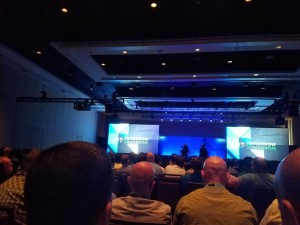Microsoft’s Ignite conference got underway earlier this morning and it didn’t take long for the updates to start flying in. Couldn’t make it to Atlanta to experience Ignite for yourself? Don’t worry.  A few members of Arraya’s Microsoft Practice are in attendance and we’ll be posting updates right here all week to keep you in the loop with what they’re seeing at Ignite.
A few members of Arraya’s Microsoft Practice are in attendance and we’ll be posting updates right here all week to keep you in the loop with what they’re seeing at Ignite.
Here’s a rundown of some of what was unveiled during this morning’s keynote address, including the latest product releases, new features, and more.
- Microsoft targeting a “Secure Productive Enterprise”
- Windows 10 is already helping to power 400 million devices, helping Microsoft and today’s organizations realize this ideal by allowing servers and devices to work together.
- 70 million Office 365 licenses have been sold and there are presently $1 billion in EMS licenses, positioning each of these solutions at the forefront of security for apps and data.
- New features coming to Office
- Microsoft is seeking to increase productivity by blurring the lines between physical paper and digital paper.
- Now in Office, you’ll be able to use a pen to strike out text in a doc and it will be deleted.
- Also, you’ll be able to take any hand drawn math equation and turn it into intelligent math that will solve the equation.
- Microsoft is seeking to increase productivity by blurring the lines between physical paper and digital paper.
- A new activity pane will reduce confusion for employees collaborating on a document from afar as it will allow them to see edits in real time.
- MyAnalytics Goals has been called a Fitbit for productivity as it will enable you to analyze how you work and set goals for improvements in different areas.
- Stormboard, a new app for Surface Hub devices, was introduced.
- This app was built to better enable project and task planning activities.
- It’s total work flow design allows users to dive in even deeper than they could using Microsoft’s previous offering in this space, Project.
- Microsoft also announced the debut of Windows Defender Application Guard.
- This utility will help make the Edge browser the most secure browser for today’s enterprise.
- It will do this via hardware-based isolation technology
- Can partner with Windows Defender Advanced Threat Protection to prevent many common machine attacks including password theft and phishing.
- Windows Defender Security Guard will be available in the next few months to Windows Insiders.
- Microsoft initiated a public preview for its brand-new service, Azure Monitor, which seems to be either an evolution of or compliment to Log Analytics.
- Metrics can build charts based on APPS or services and data within them
- Alerts can let you know when issues or events occur
- Miscellaneous News and Notes
- Adobe will now be using Azure to power all of their cloud-based solutions
- Improvements are on the way for Security Center in Analytics.
- Tech Preview 2 of Azure Stack is now available.
- Windows Server 2016 to include commercial version of Docker free.
- Windows Server 2016 and System Center 2016 are both now Generally Available
- Development in VSTS is expanding to all languages and platforms, making the dream of “Any language, Any platform” a reality
Stay in the loop with the latest from Ignite 2016
Be sure to check back here for more updates from Ignite 2016 provided by our Microsoft team throughout the week. Also, follow us on Twitter, LinkedIn, and Facebook for even more.
 my father’s office building. My father owned an actuarial firm in Allentown, located in the Corporate Plaza right downtown.
my father’s office building. My father owned an actuarial firm in Allentown, located in the Corporate Plaza right downtown.






